MERCEDES-BENZ ML SUV 2008 Owners Manual
Manufacturer: MERCEDES-BENZ, Model Year: 2008, Model line: ML SUV, Model: MERCEDES-BENZ ML SUV 2008Pages: 381, PDF Size: 7.18 MB
Page 181 of 381
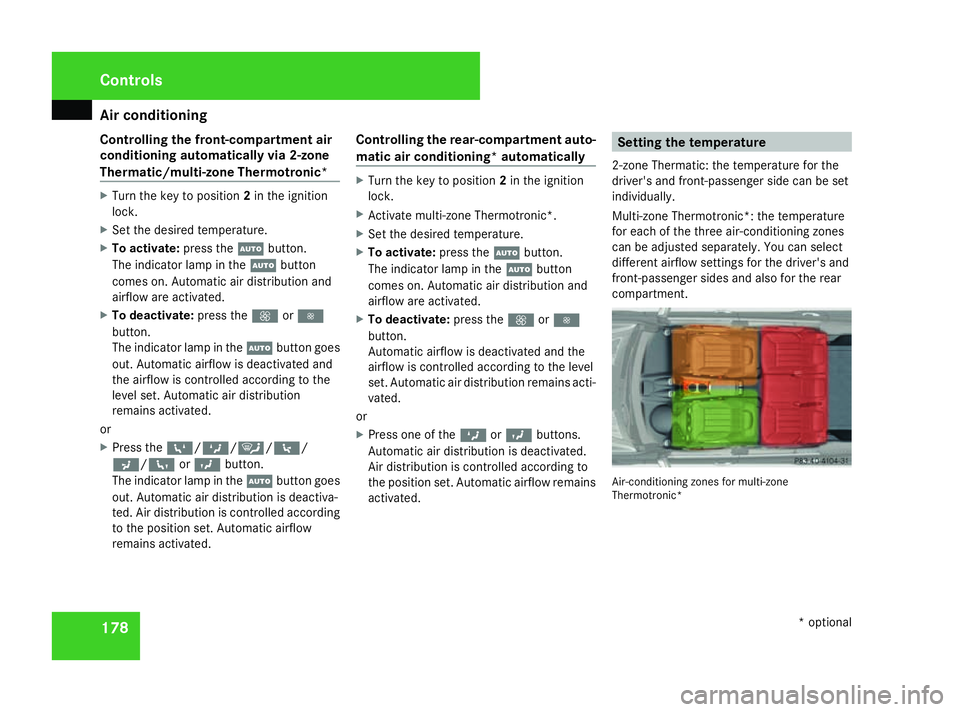
Air conditioning
178
Controlling the front-compartment air
conditioning automatically via 2-zone
Thermatic/multi-zone Thermotronic* X
Turn the key to position 2in the ignition
lock.
X Set the desired temperature.
X To activate: press theUbutton.
The indicator lamp in the Ubutton
comes on. Automatic air distribution and
airflow are activated.
X To deactivate: press theQor·
button.
The indicator lamp in the Ubutton goes
out. Automatic airflow is deactivated and
the airflow is controlled according to the
level set. Automatic air distribution
remains activated.
or
X Press the 6/Z/{/7/
a/ 8orY button.
The indicator lamp in the Ubutton goes
out. Automatic air distribution is deactiva-
ted. Air distribution is controlled according
to the position set. Automatic airflow
remains activated. Controlling the rear-compartment auto-
matic air conditioning* automatically X
Turn the key to position 2in the ignition
lock.
X Activate multi-zone Thermotronic*.
X Set the desired temperature.
X To activate: press theUbutton.
The indicator lamp in the Ubutton
comes on. Automatic air distribution and
airflow are activated.
X To deactivate: press theQor·
button.
Automatic airflow is deactivated and the
airflow is controlled according to the level
set. Automatic air distribution remains acti-
vated.
or
X Press one of the ZorY buttons.
Automatic air distribution is deactivated.
Air distribution is controlled according to
the position set. Automatic airflow remains
activated. Setting the temperature
2-zone Thermatic: the temperature for the
driver's and front-passenger side can be set
individually.
Multi-zone Thermotronic*: the temperature
for each of the three air-conditioning zones
can be adjusted separately. You can select
different airflow settings for the driver's and
front-passenger sides and also for the rear
compartment. Air-conditioning zones for multi-zone
Thermotronic*Cont
rols
* optional
164_AKB; 5; 5, en-GB
wobuchh
,V ersion: 2.10.6
2008-05-11T11:55:12+02:00 - Seite 178 Dateiname: 6515_4293_02_buchblock.pdf; preflight
Page 182 of 381
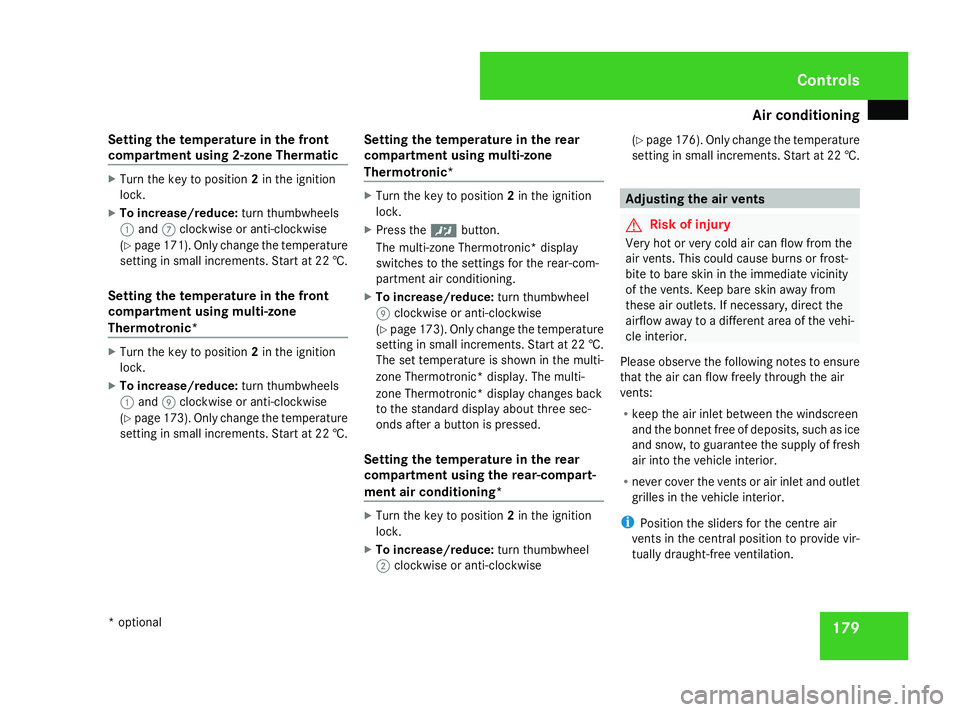
Air conditioning
179
Setting the temperature in the front
compartment using 2-zone Thermatic X
Turn the key to position 2in the ignition
lock.
X To increase/reduce: turn thumbwheels
1 and 7clockwise or anti-clockwise
(Y page 171). Only change the temperature
setting in small increments. Start at 22 †.
Setting the temperature in the front
compartment using multi-zone
Thermotronic* X
Turn the key to position 2in the ignition
lock.
X To increase/reduce: turn thumbwheels
1 and 9clockwise or anti-clockwise
(Y page 173). Only change the temperature
setting in small increments. Start at 22 †. Setting the temperature in the rear
compartment using multi-zone
Thermotronic* X
Turn the key to position 2in the ignition
lock.
X Press the ™button.
The multi-zone Thermotronic* display
switches to the settings for the rear-com-
partment air conditioning.
X To increase/reduce: turn thumbwheel
9 clockwise or anti-clockwise
(Y page 173). Only change the temperature
setting in small increments. Start at 22 †.
The set temperature is shown in the multi-
zone Thermotronic* display. The multi-
zone Thermotronic* display changes back
to the standard display about three sec-
onds after a button is pressed.
Setting the temperature in the rear
compartment using the rear-compart-
ment air conditioning* X
Turn the key to position 2in the ignition
lock.
X To increase/reduce: turn thumbwheel
2 clockwise or anti-clockwise (Y
page 176). Only change the temperature
setting in small increments. Start at 22 †. Adjusting the air vents
G
Risk of injury
Very hot or very cold air can flow from the
air vents. This could cause burns or frost-
bite to bare skin in the immediate vicinity
of the vents. Keep bare skin away from
these air outlets. If necessary, direct the
airflow away to a different area of the vehi-
cle interior.
Please observe the following notes to ensure
that the air can flow freely through the air
vents:
R keep the air inlet between the windscreen
and the bonnet free of deposits, such as ice
and snow, to guarantee the supply of fresh
air into the vehicle interior.
R never cover the vents or air inlet and outlet
grilles in the vehicle interior.
i Position the sliders for the centre air
vents in the central position to provide vir-
tually draught-free ventilation. Cont
rols
* optional
164_AKB; 5; 5, en-GB
wobuchh
,V ersion: 2.10.6
2008-05-11T11:55:12+02:00 - Seite 179 ZDateiname: 6515_4293_02_buchblock.pdf; preflight
Page 183 of 381
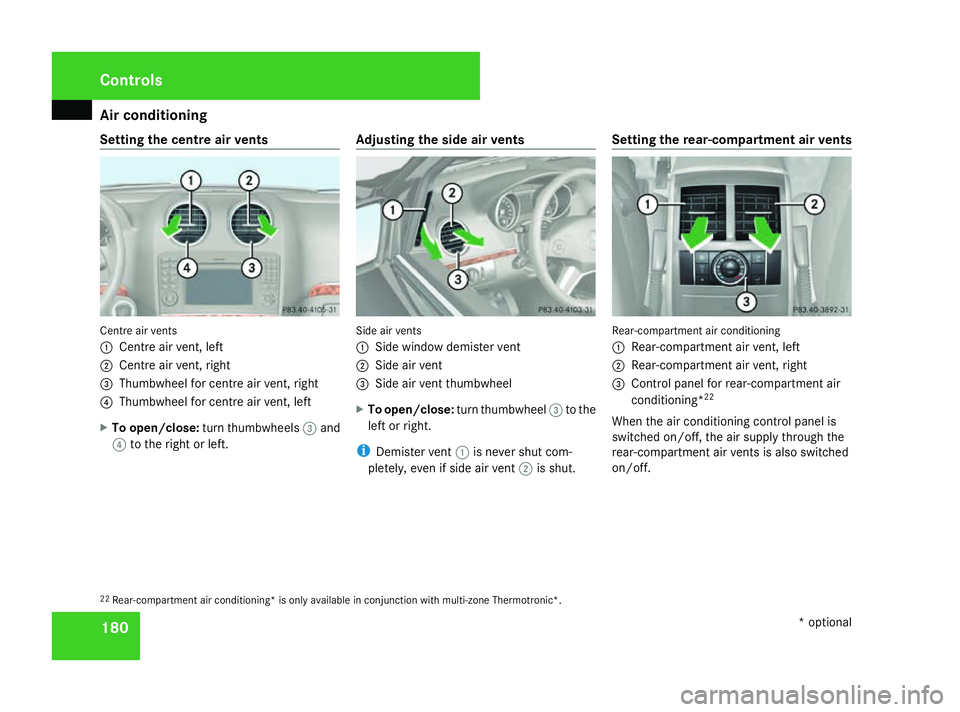
Air conditioning
180
Setting the centre air vents
Centre air vents
1
Centre air vent, left
2 Centre air vent, right
3 Thumbwheel for centre air vent, right
4 Thumbwheel for centre air vent, left
X To open/close: turn thumbwheels 3and
4 to the right or left. Adjusting the side air vents Side air vents
1
Side window demister vent
2 Side air vent
3 Side air vent thumbwheel
X To open/close: turn thumbwheel 3to the
left or right.
i Demister vent 1is never shut com-
pletely, even if side air vent 2is shut. Setting the rear-compartment air vents Rear-compartment air conditioning
1
Rear-compartment air vent, left
2 Rear-compartment air vent, right
3 Control panel for rear-compartment air
conditioning* 22
When the air conditioning control panel is
switched on/off, the air supply through the
rear-compartment air vents is also switched
on/off.
22 Rear-compartment air conditioning* is only available in conjunction with multi-zone Thermotronic*. Cont
rols
* optional
164_AKB; 5; 5, en-GB
wobuchh
,V ersion: 2.10.6
2008-05-11T11:55:12+02:00 - Seite 180 Dateiname: 6515_4293_02_buchblock.pdf; preflight
Page 184 of 381
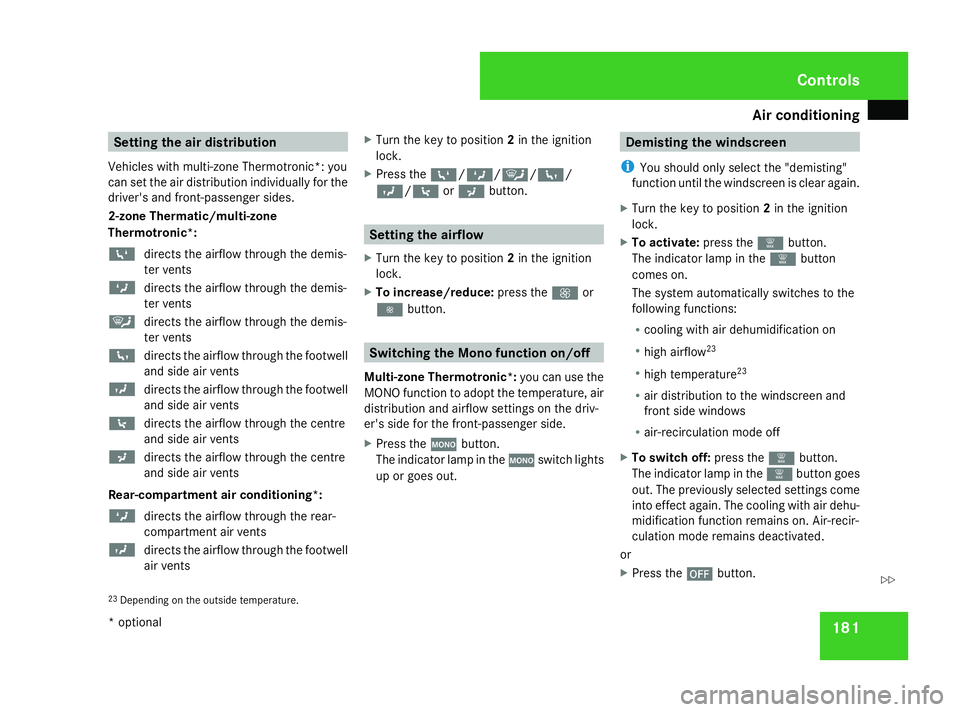
Air conditioning
181Setting the air distribution
Vehicles with multi-zone Thermotronic*: you
can set the air distribution individually for the
driver's and front-passenger sides.
2-zone Thermatic/multi-zone
Thermotronic*:
6 directs the airflow through the demis-
ter vents
Z directs the airflow through the demis-
ter vents
{ directs the airflow through the demis-
ter vents
8 directs the airflow through the footwell
and side air vents
Y directs the airflow through the footwell
and side air vents
7 directs the airflow through the centre
and side air vents
a directs the airflow through the centre
and side air vents
Rear-compartment air conditioning*:
Z directs the airflow through the rear-
compartment air vents
Y directs the airflow through the footwell
air vents X
Turn the key to position 2in the ignition
lock.
X Press the 6/Z/{/8/
Y/ 7ora button. Setting the airflow
X Turn the key to position 2in the ignition
lock.
X To increase/reduce: press theQor
· button. Switching the Mono function on/off
Multi-zone Thermotronic*: you can use the
MONO function to adopt the temperature, air
distribution and airflow settings on the driv-
er's side for the front-passenger side.
X Press the zbutton.
The indicator lamp in the zswitch lights
up or goes out. Demisting the windscreen
i You should only select the "demisting"
function until the windscreen is clear again.
X Turn the key to position 2in the ignition
lock.
X To activate: press the|button.
The indicator lamp in the |button
comes on.
The system automatically switches to the
following functions:
R cooling with air dehumidification on
R high airflow 23
R high temperature 23
R air distribution to the windscreen and
front side windows
R air-recirculation mode off
X To switch off: press the|button.
The indicator lamp in the |button goes
out. The previously selected settings come
into effect again. The cooling with air dehu-
midification function remains on. Air-recir-
culation mode remains deactivated.
or
X Press the ´button.
23 Depending on the outside temperature. Cont
rols
* optional
164_AKB; 5; 5, en-GB
wobuchh
,V ersion: 2.10.6
2008-05-11T11:55:12+02:00 - Seite 181 ZDateiname: 6515_4293_02_buchblock.pdf; preflight
Page 185 of 381
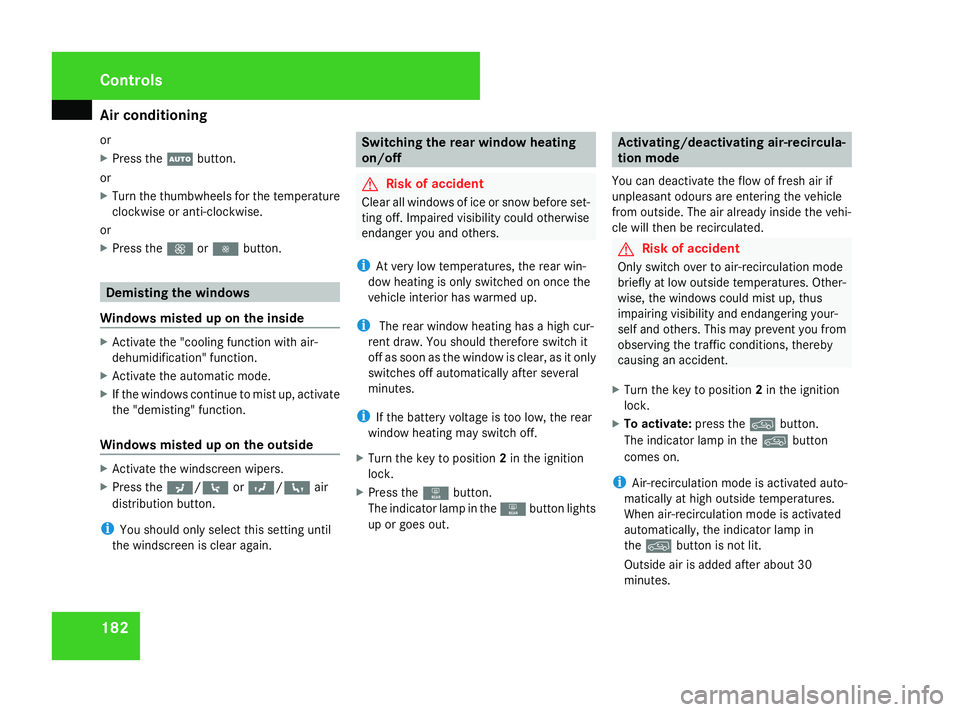
Air conditioning
182
or
X
Press the Ubutton.
or
X Turn the thumbwheels for the temperature
clockwise or anti-clockwise.
or
X Press the Qor· button. Demisting the windows
Windows misted up on the inside X
Activate the "cooling function with air-
dehumidification" function.
X Activate the automatic mode.
X If the windows continue to mist up, activate
the "demisting" function.
Windows misted up on the outside X
Activate the windscreen wipers.
X Press the a/7orY/ 8air
distribution button.
i You should only select this setting until
the windscreen is clear again. Switching the rear window heating
on/off G
Risk of accident
Clear all windows of ice or snow before set-
ting off. Impaired visibility could otherwise
endanger you and others.
i At very low temperatures, the rear win-
dow heating is only switched on once the
vehicle interior has warmed up.
i The rear window heating has a high cur-
rent draw. You should therefore switch it
off as soon as the window is clear, as it only
switches off automatically after several
minutes.
i If the battery voltage is too low, the rear
window heating may switch off.
X Turn the key to position 2in the ignition
lock.
X Press the 1button.
The indicator lamp in the 1button lights
up or goes out. Activating/deactivating air-recircula-
tion mode
You can deactivate the flow of fresh air if
unpleasant odours are entering the vehicle
from outside. The air already inside the vehi-
cle will then be recirculated. G
Risk of accident
Only switch over to air-recirculation mode
briefly at low outside temperatures. Other-
wise, the windows could mist up, thus
impairing visibility and endangering your-
self and others. This may prevent you from
observing the traffic conditions, thereby
causing an accident.
X Turn the key to position 2in the ignition
lock.
X To activate: press the:button.
The indicator lamp in the :button
comes on.
i Air-recirculation mode is activated auto-
matically at high outside temperatures.
When air-recirculation mode is activated
automatically, the indicator lamp in
the : button is not lit.
Outside air is added after about 30
minutes. Cont
rols
164_AKB; 5; 5, en-GB
wobuchh
,V ersion: 2.10.6
2008-05-11T11:55:12+02:00 - Seite 182 Dateiname: 6515_4293_02_buchblock.pdf; preflight
Page 186 of 381
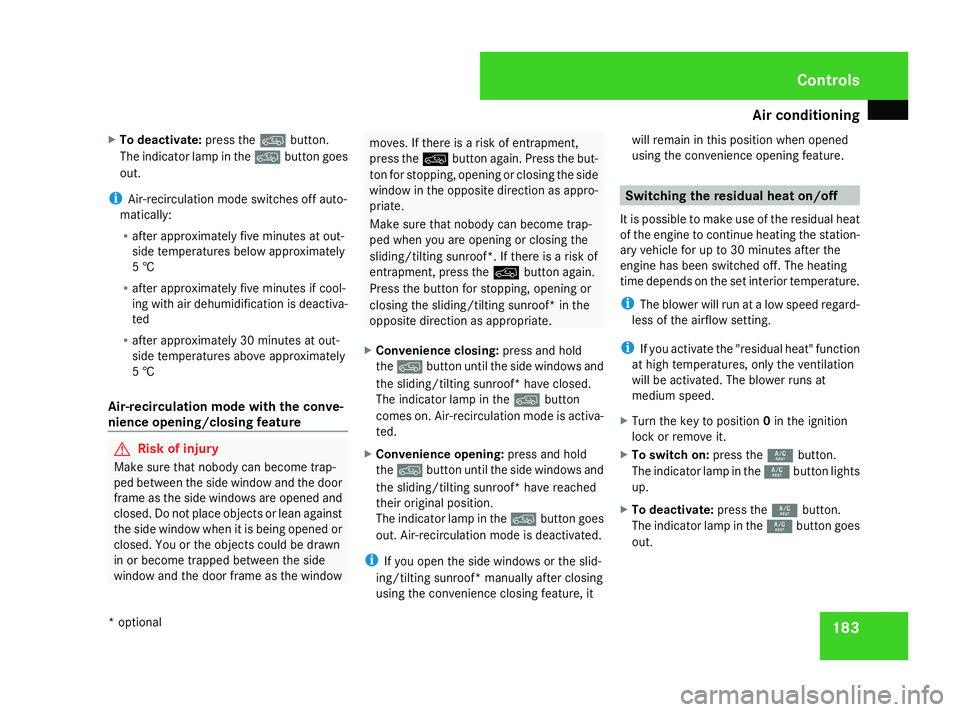
Air conditioning
183
X
To deactivate: press the:button.
The indicator lamp in the :button goes
out.
i Air-recirculation mode switches off auto-
matically:
R after approximately five minutes at out-
side temperatures below approximately
5 †
R after approximately five minutes if cool-
ing with air dehumidification is deactiva-
ted
R after approximately 30 minutes at out-
side temperatures above approximately
5 †
Air-recirculation mode with the conve-
nience opening/closing feature G
Risk of injury
Make sure that nobody can become trap-
ped between the side window and the door
frame as the side windows are opened and
closed. Do not place objects or lean against
the side window when it is being opened or
closed. You or the objects could be drawn
in or become trapped between the side
window and the door frame as the window moves. If there is a risk of entrapment,
press the :button again. Press the but-
ton for stopping, opening or closing the side
window in the opposite direction as appro-
priate.
Make sure that nobody can become trap-
ped when you are opening or closing the
sliding/tilting sunroof*. If there is a risk of
entrapment, press the :button again.
Press the button for stopping, opening or
closing the sliding/tilting sunroof* in the
opposite direction as appropriate.
X Convenience closing: press and hold
the : button until the side windows and
the sliding/tilting sunroof* have closed.
The indicator lamp in the :button
comes on. Air-recirculation mode is activa-
ted.
X Convenience opening: press and hold
the : button until the side windows and
the sliding/tilting sunroof* have reached
their original position.
The indicator lamp in the :button goes
out. Air-recirculation mode is deactivated.
i If you open the side windows or the slid-
ing/tilting sunroof* manually after closing
using the convenience closing feature, it will remain in this position when opened
using the convenience opening feature. Switching the residual heat on/off
It is possible to make use of the residual heat
of the engine to continue heating the station-
ary vehicle for up to 30 minutes after the
engine has been switched off. The heating
time depends on the set interior temperature.
i The blower will run at a low speed regard-
less of the airflow setting.
i If you activate the "residual heat" function
at high temperatures, only the ventilation
will be activated. The blower runs at
medium speed.
X Turn the key to position 0in the ignition
lock or remove it.
X To switch on: press the9button.
The indicator lamp in the 9button lights
up.
X To deactivate: press the9button.
The indicator lamp in the 9button goes
out. Cont
rols
* optional
164_AKB; 5; 5, en-GB
wobuchh
,V ersion: 2.10.6
2008-05-11T11:55:12+02:00 - Seite 183 ZDateiname: 6515_4293_02_buchblock.pdf; preflight
Page 187 of 381
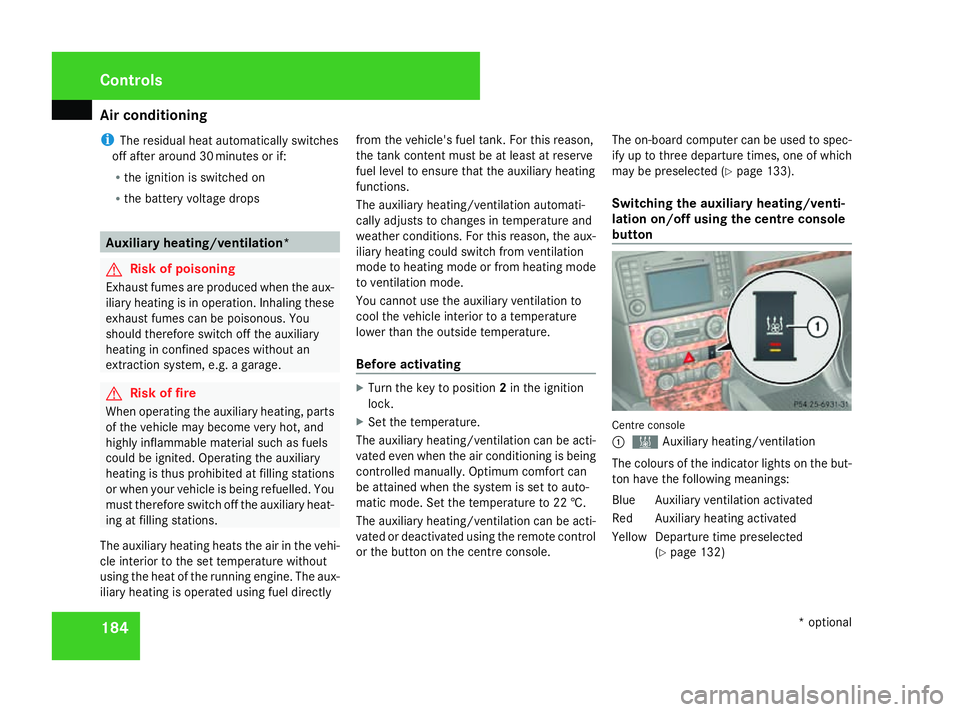
Air conditioning
184
i
The residual heat automatically switches
off after around 30 minutes or if:
R the ignition is switched on
R the battery voltage drops Auxiliary heating/ventilation*
G
Risk of poisoning
Exhaust fumes are produced when the aux-
iliary heating is in operation. Inhaling these
exhaust fumes can be poisonous. You
should therefore switch off the auxiliary
heating in confined spaces without an
extraction system, e.g. a garage. G
Risk of fire
When operating the auxiliary heating, parts
of the vehicle may become very hot, and
highly inflammable material such as fuels
could be ignited. Operating the auxiliary
heating is thus prohibited at filling stations
or when your vehicle is being refuelled. You
must therefore switch off the auxiliary heat-
ing at filling stations.
The auxiliary heating heats the air in the vehi-
cle interior to the set temperature without
using the heat of the running engine. The aux-
iliary heating is operated using fuel directly from the vehicle's fuel tank. For this reason,
the tank content must be at least at reserve
fuel level to ensure that the auxiliary heating
functions.
The auxiliary heating/ventilation automati-
cally adjusts to changes in temperature and
weather conditions. For this reason, the aux-
iliary heating could switch from ventilation
mode to heating mode or from heating mode
to ventilation mode.
You cannot use the auxiliary ventilation to
cool the vehicle interior to a temperature
lower than the outside temperature.
Before activating
X
Turn the key to position 2in the ignition
lock.
X Set the temperature.
The auxiliary heating/ventilation can be acti-
vated even when the air conditioning is being
controlled manually. Optimum comfort can
be attained when the system is set to auto-
matic mode. Set the temperature to 22 †.
The auxiliary heating/ventilation can be acti-
vated or deactivated using the remote control
or the button on the centre console. The on-board computer can be used to spec-
ify up to three departure times, one of which
may be preselected (Y
page 133).
Switching the auxiliary heating/venti-
lation on/off using the centre console
button Centre console
1
X Auxiliary heating/ventilation
The colours of the indicator lights on the but-
ton have the following meanings:
Blu eA uxiliary ventilation activated
Red Auxiliary heating activated
Yello wDeparture time preselected
(Y page 132) Controls
* optional
164_AKB; 5; 5, en-GB
wobuchh,
Version: 2.10.6 2008-05-11T11:55:12+02:00 - Seite 184Dateiname: 6515_4293_02_buchblock.pdf; preflight
Page 188 of 381
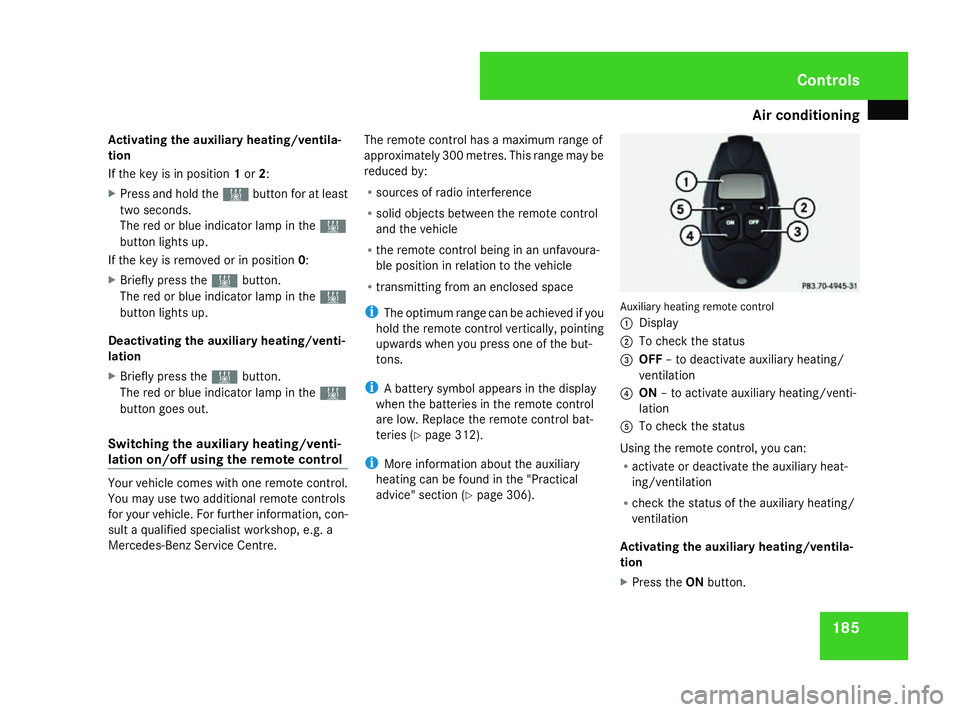
Air conditioning
185
Activating the auxiliary heating/ventila-
tion
If the key is in position 1or 2:
X Press and hold the Xbutton for at least
two seconds.
The red or blue indicator lamp in the X
button lights up.
If the key is removed or in position 0:
X Briefly press the Xbutton.
The red or blue indicator lamp in the X
button lights up.
Deactivating the auxiliary heating/venti-
lation
X Briefly press the Xbutton.
The red or blue indicator lamp in the X
button goes out.
Switching the auxiliary heating/venti-
lation on/off using the remote control Your vehicle comes with one remote control.
You may use two additional remote controls
for your vehicle. For further information, con-
sult a qualified specialist workshop, e.g. a
Mercedes-Benz Service Centre. The remote control has a maximum range of
approximately 300 metres. This range may be
reduced by:
R sources of radio interference
R solid objects between the remote control
and the vehicle
R the remote control being in an unfavoura-
ble position in relation to the vehicle
R transmitting from an enclosed space
i The optimum range can be achieved if you
hold the remote control vertically, pointing
upwards when you press one of the but-
tons.
i A battery symbol appears in the display
when the batteries in the remote control
are low. Replace the remote control bat-
teries (Y page 312).
i More information about the auxiliary
heating can be found in the "Practical
advice" section (Y page 306). Auxiliary heating remote control
1
Display
2 To check the status
3 OFF – to deactivate auxiliary heating/
ventilation
4 ON – to activate auxiliary heating/venti-
lation
5 To check the status
Using the remote control, you can:
R activate or deactivate the auxiliary heat-
ing/ventilation
R check the status of the auxiliary heating/
ventilation
Activating the auxiliary heating/ventila-
tion
X Press the ONbutton. Cont
rols
164_AKB; 5; 5, en-GB
wobuchh
,V ersion: 2.10.6
2008-05-11T11:55:12+02:00 - Seite 185 ZDateiname: 6515_4293_02_buchblock.pdf; preflight
Page 189 of 381
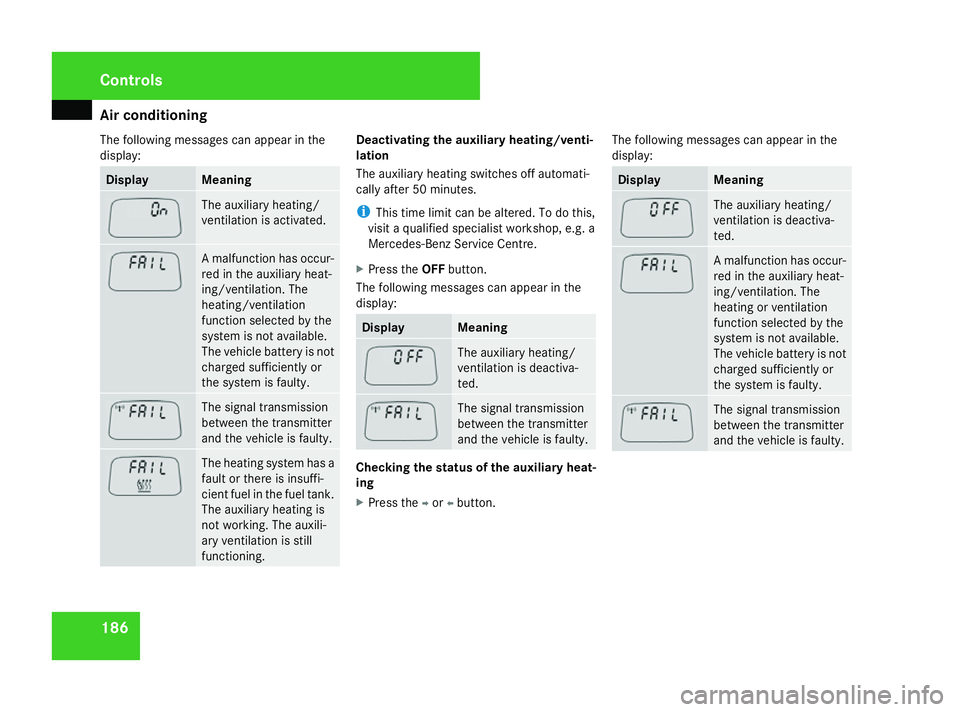
Air conditioning
186
The following messages can appear in the
display: Display Meaning
The auxiliary heating/
ventilation is activated.
A malfunction has occur-
red in the auxiliary heat-
ing/ventilation. The
heating/ventilation
function selected by the
system is not available.
The vehicle battery is not
charged sufficiently or
the system is faulty. The signal transmission
between the transmitter
and the vehicle is faulty.
The heating system has a
fault or there is insuffi-
cient fuel in the fuel tank.
The auxiliary heating is
not working. The auxili-
ary ventilation is still
functioning. Deactivating the auxiliary heating/venti-
lation
The auxiliary heating switches off automati-
cally after 50 minutes.
i
This time limit can be altered. To do this,
visit a qualified specialist workshop, e.g. a
Mercedes-Benz Service Centre.
X Press the OFFbutton.
The following messages can appear in the
display: Display Meaning
The auxiliary heating/
ventilation is deactiva-
ted.
The signal transmission
between the transmitter
and the vehicle is faulty.
Checking the status of the auxiliary heat-
ing
X
Press the por obutton. The following messages can appear in the
display: Display Meaning
The auxiliary heating/
ventilation is deactiva-
ted.
A malfunction has occur-
red in the auxiliary heat-
ing/ventilation. The
heating or ventilation
function selected by the
system is not available.
The vehicle battery is not
charged sufficiently or
the system is faulty.
The signal transmission
between the transmitter
and the vehicle is faulty. Cont
rols
164_AKB; 5; 5, en-GB
wobuchh
,V ersion: 2.10.6
2008-05-11T11:55:12+02:00 - Seite 186 Dateiname: 6515_4293_02_buchblock.pdf; preflight
Page 190 of 381
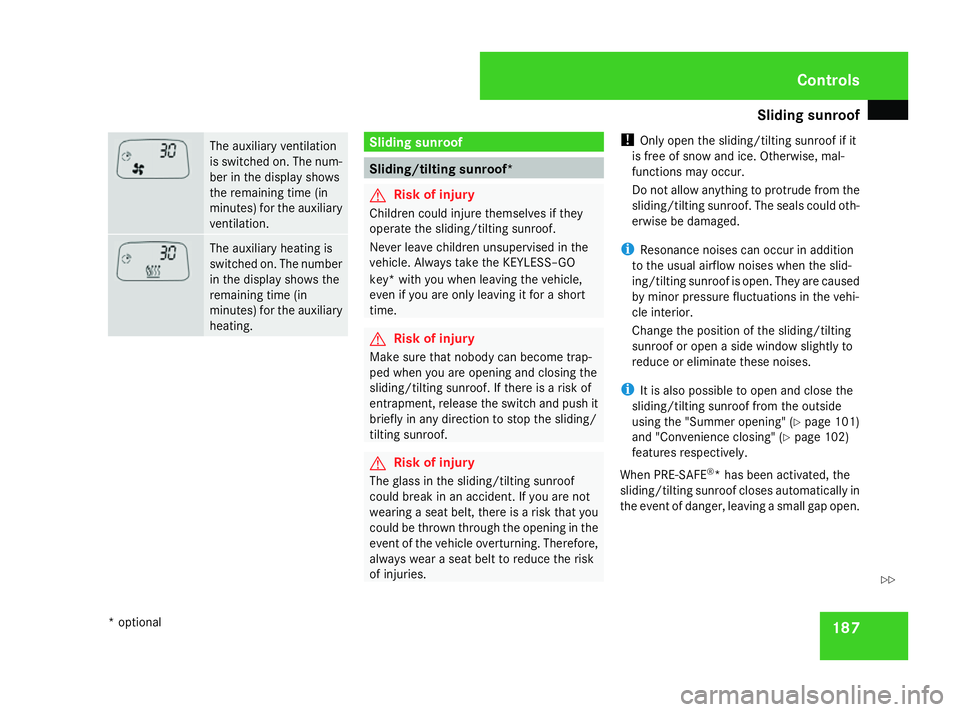
Sliding sunroof
187The auxiliary ventilation
is switched on. The num-
ber in the display shows
the remaining time (in
minutes) for the auxiliary
ventilation.
The auxiliary heating is
switched on. The number
in the display shows the
remaining time (in
minutes) for the auxiliary
heating. Sliding sunroof
Sliding/tilting sunroof*
G
Risk of injury
Children could injure themselves if they
operate the sliding/tilting sunroof.
Never leave children unsupervised in the
vehicle. Always take the KEYLESS–GO
key* with you when leaving the vehicle,
even if you are only leaving it for a short
time. G
Risk of injury
Make sure that nobody can become trap-
ped when you are opening and closing the
sliding/tilting sunroof. If there is a risk of
entrapment, release the switch and push it
briefly in any direction to stop the sliding/
tilting sunroof. G
Risk of injury
The glass in the sliding/tilting sunroof
could break in an accident. If you are not
wearing a seat belt, there is a risk that you
could be thrown through the opening in the
event of the vehicle overturning. Therefore,
always wear a seat belt to reduce the risk
of injuries. !
Only open the sliding/tilting sunroof if it
is free of snow and ice. Otherwise, mal-
functions may occur.
Do not allow anything to protrude from the
sliding/tilting sunroof. The seals could oth-
erwise be damaged.
i Resonance noises can occur in addition
to the usual airflow noises when the slid-
ing/tilting sunroof is open. They are caused
by minor pressure fluctuations in the vehi-
cle interior.
Change the position of the sliding/tilting
sunroof or open a side window slightly to
reduce or eliminate these noises.
i It is also possible to open and close the
sliding/tilting sunroof from the outside
using the "Summer opening" (Y page 101)
and "Convenience closing" (Y page 102)
features respectively.
When PRE-SAFE ®
* has been activated, the
sliding/tilting sunroof closes automatically in
the event of danger, leaving a small gap open. Controls
* optional
164_AKB; 5; 5, en-GB
wobuchh,
Version: 2.10.6 2008-05-11T11:55:12+02:00 - Seite 187 ZDateiname: 6515_4293_02_buchblock.pdf; preflight